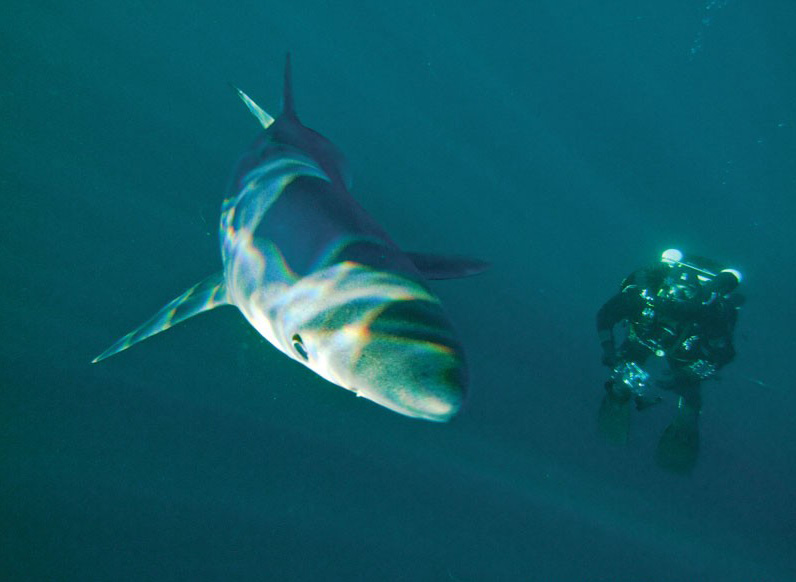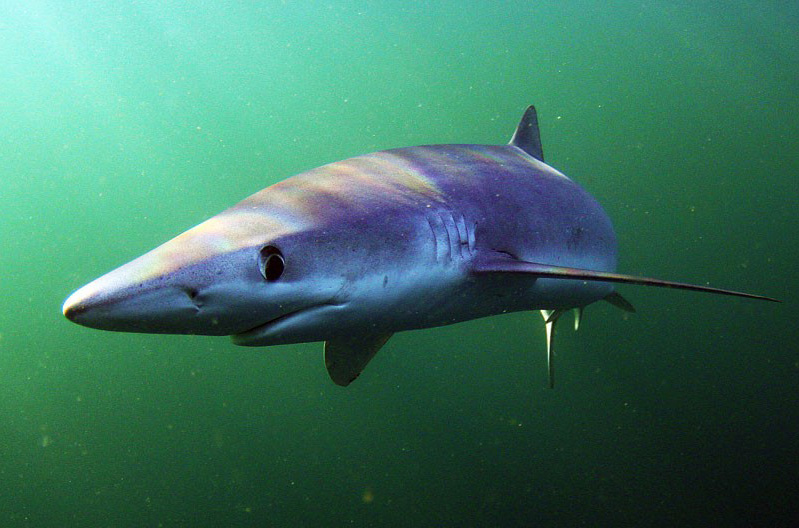When San Diego divers think of local shark diving, they can immediately name many species seen on a regular basis – Horn shark (Heterodontus francisci), Leopard shark (Triakis semifasciata), Angel Shark (Squatina californica) etc. While these are regularly encountered and magnificent to see, for the most part they are a smaller species which the average person does not depict as the stereotypical shark.

Ten years ago a diver could jump on a local boat, be whisked off to an offshore location, jump in a cage and see the spectacular endemic pelagic shark species. Tragically, the Pacific shark finning trade has drastically depleted shark populations, and these charters were ceased.
San Diego’s blue waters are home to two of the world’s most elegant elasmobranchs – the Blue shark (Prionace glauca) and the Shortfin Mako (Isurus oxyrinchus). Blues are a slender shark, able to reach over twelve feet long, and are adapted for long migrations to patrol the open ocean for a meal. Blues are notorious for turning up at the right place at the right time to gorge on seasonally abundant food. The mating and spawning squid off California are a prime example of this.
Although found in many of the world’s oceans, San Diego is listed as one of the premier Blue shark diving locations (The Shark Watcher’s Handbook, Mark Carwardine and Ken Watterson, 2002). San Diego is also one of the top Mako diving locations. Makos are a pursuit predator, and actively chase down fleeing prey. The Mako has a sophisticated countercurrent circulatory system, which basically means they are endotherms (warm-blooded), which is an adaptation for fast swimming and gives them an advantage over cold-blooded prey.
On December 4th 2010, San Diego-based Ocean Explorers headed out on one of their blue water shark trips aboard the Andrea M. She is the ideal boat for such a trip, as she is towed to the optimum launch ramp for the planned dive site and is an extremely fast and stable aluminum chambered hull boat.
We loaded up our gear onto the boat at 6:30am at Dana Launch ramp in Mission Bay and were on our way at 7:00am. On the way out we were served Brie and crackers, pita chips and dip. With sandwiches and clam chowder to come, gourmet food for a day charter, I started to feel like I should have brought a nice Bordeaux wine instead of beers for the journey back in. Motoring at twenty six knots, it only took us an hour to reach our destination thirteen nautical miles due west of Torrey pines.
With over-cast skies and a cold wind blowing, we began chumming the water. All eyes scanned the water’s surface, and we waited patiently for three hours with only a few Mola molas sighted. Although it is normal for the pelagic sharks not to show for three to five hours, we were all thinking the same thought: will we get sharks today?
After three and a half hours of chumming, the skies cleared and the wind died. As the seas calmed I spotted a dorsal fin break the surface around the chum bucket. Our guest had arrived. It was a juvenile three foot Blue shark. As fast as lightning, we all donned our wetsuits and splashed. To our disappointment the animal took off and none of us saw it sub-surface. Climbing back onto the boat we all hoped another would show.
After half an hour Captain Danny Howard yelled out, “shark!” A beautiful six foot Blue could be seen circling the bucket. Then a second six foot Blue joined as we were entering the water. With all others free diving (to not scare away the sharks with noisy bubbles) and me on my rebreather, nice and silent, we hovered around the chum bucket patiently waiting to see if the sharks had fled or if they were players and would return.
For the next three hours, we experienced ultimate blue water shark diving. We all hung between the boat and bucket, looking through the clear blue water into the cloudy, oily slick of chum. First the male Blue would come in. Ignoring us, he would head directly for the bucket and after a little taste would change direction and vanished into the slick. Next the female would appear. She would approach a diver inquisitively, and a little push to the nose would deter her enough to move onto the next diver. After investigating all individuals she, like the male, would taste the bucket and retreat out of view. After a minute, both would return and repeat the dance.
Respectfully, one to two divers at a time would don their scuba equipment and join the free divers in the water to not scare the sharks off with excessive bubbles. For the entire three hours, on my rebreather, I hung at five to fifteen feet waiting for the female to come investigate me. She would swim directly towards me, pectoral fins spread. To avoid a test nibble, all that was required from me was to place my hand on the top of her nose and push her down. I could see her enormous coal black eye looking at me, and then as she swam beneath me, I would stroke my hand along the length of her indigo-blue satin back. To our amazement a third Blue decided to join in the fun to finish off the diving for the day.
After four hours of stunning shark encounters, all boarded the boat, cracked open some beers and pulled the chum buckets closer to the boat. For the next hour we enjoyed good beer and good cheer as we admired the beautiful sharks beneath us and the biblical sunset before us.
Words and photos by Michael Kazma
BIO:
Michael Kazma completed his Open Water Diver certification at age 13 in Beirut, Lebanon. He advanced through the recreational and technical diver and instructor courses, and at 18 became an Advanced Nitrox Instructor. After instructing in Lebanon and then Hawaii, he moved to California, where he fell in love with wreck and shark diving. Currently, Michael is a technical scuba instructor, CCR diver, scientific research diver and has logged well over 1000 logged dives.



